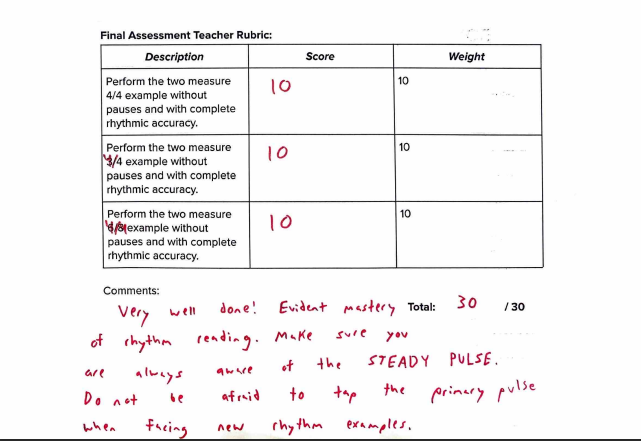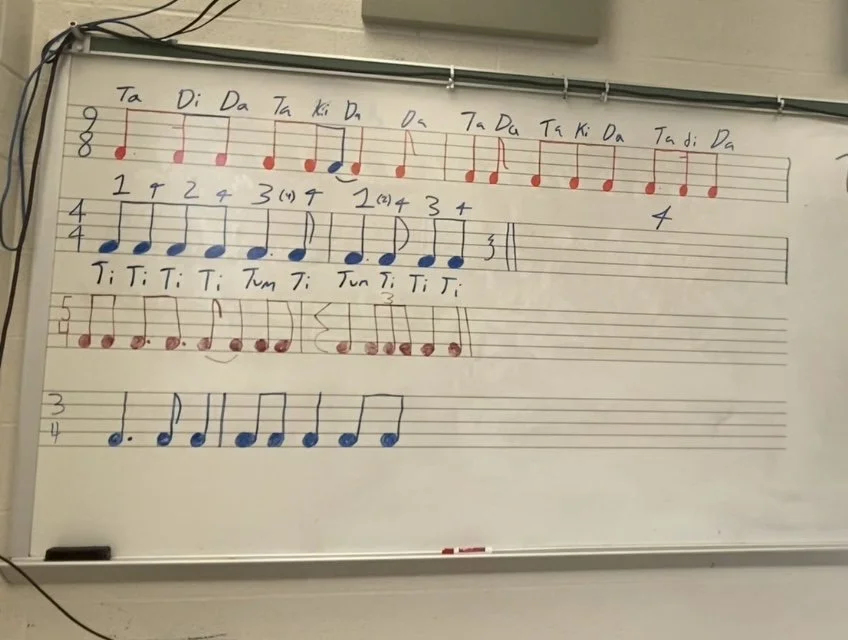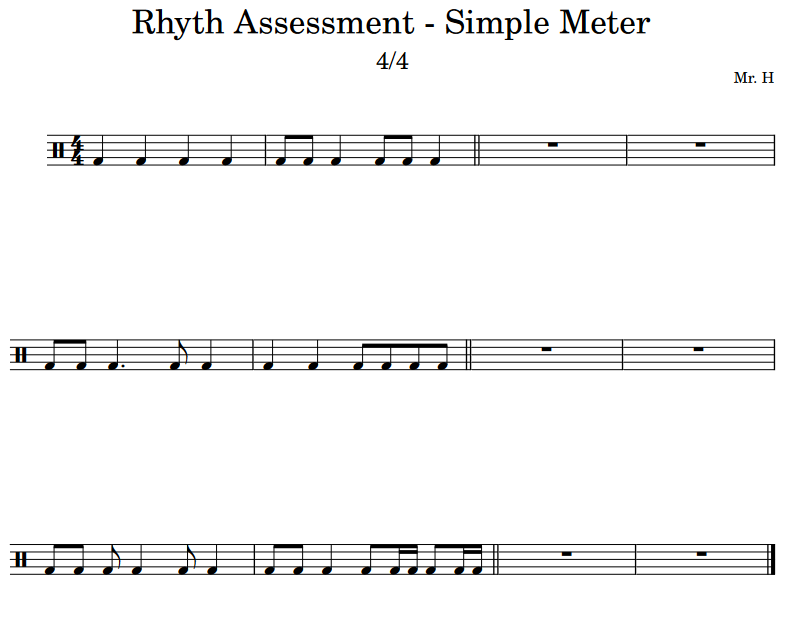
ASSESSING STUDENT LEARNING
Document Student Learning
Reference time stamps from INDIVIDUAL LESSON ANALYSES: “Evidence of Student Learning” subsections.
Link to Final Assessment Example with Student B.
Below are assessment examples. The first two documents are examples of individual work from the student-created rhythm activity in Lesson 1. The following four pictures/documents are completed rubrics from the final assessment. The last picture is the documented assessment of student learning from the whiteboard notation activity in Lesson 1. To see the entire document, click on the image.
PROVIDE ASSESSMENT INSTRUMENTS
Below is the first page from my Rhythm Creation/Reading/Performance Packet. The primary goal and mini-unit schedule are clearly stated. The teacher rubric for the final assessment is presented here, as well. The other picture/document is the Rhythm Assessment - Simple Meter assessment examples. The order of the examples is 1st-3rd, top to bottom. Other activity pages and materials can be found linked in the lesson plans.
ASSESSMENT COMMENTARY
What assessment strategies were used and why?
Informal Formative:
Across all lessons, I observed student participation in discussions, student applied effort in rhythm performance activities, and student applied effort in independent work. Ask and Analyze is crucial to student and teacher success in the classroom, as outlined in Burgess’ Teach Like a PIRATE. For me, these informal observations provided an opportunity for immediate instructional feedback: what is not working? where are the students at? what do I need to adjust, right now, to best serve their specific needs? Continual informal assessment is at the heart of Ask, from there I can Analyze to ensure my lesson is scaffolding concepts appropriately and building long-lasting connections.
Informal Formative:
I documented the student-created examples from the whiteboard. This informal assessment showcases current student skill levels. During lesson 1, I also facilitated peer-peer assessment during this activity. This student-ownership in learning resulted in great questions related to general concept principles. Based on student performance and student response, I adjusted the lesson to address “ice-cube-trays” and halfway points in the context of rhythm aesthetics. Students responded further, thinking critically about the contributions of each other. I am not only able to assess individual performance of rhythm notation, but I am also able to assess student ability in error detection, which elicits higher level confidence with the material.
Informal Formative:
Independent student work was collected at the end of lesson 2. This assessment represented student engagement and effort in class activities. In analyzing the work of each student, I am able to assess specific areas that need clarification. In planning for future lessons, I can revise my instruction to meet those specific areas of weakness. For example, syncopation presented a continual issue into lesson 3, which identifies a prevalent need for scaffolding adjustment in the context of off-beat rhythms.
Formal Summative:
1-on-1 final assessment for the mini-unit. Each student performs three rhythm excerpts for T, based on the worksheets practiced in the lessons prior. This provides students the opportunities to showcase learning without the pressure of peers. 1-on-1 assessments also offer opportunities for individual feedback that is not usually possible in the everyday class environment. Students may feel more comfortable expressing concerns to the teacher when presented an opportunity before or following the individual assessment. This assessment uses a rubric, with 10 points possible for each excerpt. If the student has steady pulse and completes the example, they are guaranteed a 60%. I was generous with the deductions for minor mistakes. The goal of this assessment is to DOCUMENT WHAT THE STUDENTS KNOW, not document what the students do not know. In this way, I am trying to give each student the most points possible, while acknowledging the weaknesses of each performance. The primary goal of this assessment strategy to place students in an environment where they may (a) feel comfortable expressing concerns/difficulties, (b) showcase well prepared skill sets, and (c) receive honest, encouraging, individualized feedback that would not be possible elsewhere.
What were your expectations for student learning and how did you communicate these expectations to students?
My expectation for student learning was the application of Takadimi/Kodály/Numbers in reading and performing rhythm examples. Throughout each lesson, I verbally communicated the expectation of discussion, independent notation of rhythms/syllables, or the expectation of group performance. If students were not performing or applying appropriate effort to class activities, I made efforts in holding students accountable: generic reminders to do the expected work, and engaging student response/discussion. Keeping momentum in the pacing also helps with student achievement in expectations, because students maintain continual engagement with the activities. For student benefit, I gave each student a packet at the beginning of Lesson 1 that contains everything they need for all three lessons. The first page could be described as the “clearly defined expectations page.” The primary goal, in simple terms, bold at the top of the page: “create, read, and perform a wide range of rhythm examples. Successfully sight-read challenging rhythm examples.” Upon reviewing this page, students immediately recognize the overall premise of the next three days. Below this, I clearly outlined the schedule of each day/lesson. Students know, from the beginning, what is happening and when it is happening. Below the schedule/routine, I presented them with the teacher rubric for the final performance assessment. Students are familiar with the grading procedure well in advance. Using an organized format similar to page 1 removes the element of surprise. Students will not have an excuse for not understanding what is expected of them during Lesson 3.
How did students accomplish the objectives for the Series of Lessons? (Cite Evidence)
In the assessment portion of each lesson plan, I outlined a clear way of identifying objective achievement using percentages of participation and percentages of accuracy in whichever area of performance. In Lesson 3, my informal observation of participation in the warm-up discussion showed accomplishment of objectives 1 and 2 only if 75% or more of students contributed to the general discussion and at least 50% of the contributions incorporated specific music concepts/terminology to defend opinions. The only critique of this method is that my observations contain bias/subjectivity/imperfections, so my interpretation of student performance is inherently variable. For this system to work, it requires me to be brutally honest, not only with my students, but with myself. For lesson 3, I perceived student participation as meeting both benchmarks of success, and so objectives 1 and 2 were met for this lesson. In Lesson 1, my assessment of student growth in rhythm performance functioned the same way. If 90% of students are attempting to identify rhythms with both Numbers and Takadimi methods, and 100% of students are participating in the group performance activities with at least a 75% individual increase in comfort with either method by the end of class, then objectives 3 and 4 will have been met. For this mouth-full benchmark, student performance must be actively assessed by me throughout the entirety of the lesson. In the video, students can be observed performing various rhythms over the course of the lesson; by the final performances of each example, students show higher level accuracy with 100% participation from the class. With all interpreted percentages meeting the benchmarks of achievement, objectives 3 and 4 were accomplished by all students for this lesson.
For the overarching goal of the mini-unit, each student was assessed individually during the final 1-on-1 rhythm assessment. The rubric clearly outlined a 30 point system, with 10 points allotted to each rhythm example. The change to all 4/4 examples was clearly communicated to the students. Comments were vocalized after each performance, with individualized support provided. Additional comments were written at the bottom of each student’s rubric, and short feedback was given in the “score” box if deductions occurred. As stated in the Lesson 3 plan, if the class average on the final assessment scored above an 85%, then objective 4, as representative of the overarching goal for this unit, will have been met. Following the scoring of each individual assessment, the class average was a 98.33%, showing accomplishment well above the benchmark for primary objective achievement. The class, as a whole, was very successful in learning and applying the concepts covered over the three days. Their achievement also reflects the success of my instruction and adjustments throughout the lessons. Regardless, I have identified many areas of weakness in my planning and instruction that I am excited to implement in the future.








